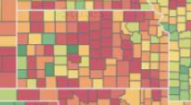We have reached a bit of a plateau in Kansas: hospitals remain pretty full and the COVID death rate remains dispiritingly high, but things are neither getting rapidly worse, like they are in California (where new cases rose 120% between Dec. 3 and Dec. 17, as compared to the previous two weeks), or steadily better, like they are in Minnesota (where new cases fell by 31% over that time). The rate of new cases in Kansas has flattened out, but it's still near the highest level it's been throughout the entire pandemic. Which makes us vulnerable to a big surge around special events, like Christmas or New Year's, if too many people gather and spread the virus around. Or, we could hunker down for a few weeks more and really turn this thing around so dozens of Kansans aren't dying every day with a vaccine that could have saved them in sight.
The Good: The infection reproduction rate, or Rt, dropped to 0.97. That's the lowest it's been since May and it's excellent news because it means that if we limit the virus to its current rate of spread (by wearing masks, social distancing, washing hands, avoiding large gatherings, etc.), we will not just flatten the curve, but bend it down.
The Bad: Hospitals have yet to really feel much relief. ICU capacity in Kansas was about 18% as of Dec. 18, according to the Kansas Hospital Association. We'd like to get that above 20% to really feel like everybody can get the type of care that will give them the best chance to survive. As mentioned in prior weeks, the capacity is not evenly distributed. Just 7% of ICU beds were available in south-central Kansas, which is largely because Wichita's hospitals remained at capacity for the seventh straight week. While new cases are finally declining in the western third of the state, the center of the state remains red-hot (see heat map below), which will continue to strain ICUs in Wichita, Salina and Hays.
The Ugly: Test positivity was largely unchanged, at a ghastly 37.7% this week, according to Johns Hopkins. That's fifth worst in the country behind Idaho, South Dakota, Alabama and Pennsylvania. We haven't tested enough since the beginning of the pandemic, and we still aren't testing enough. At the beginning we just didn't have the capacity to test enough, but now I think we do. I'm guessing some of our shortfalls now stem from geographic challenges (it's a long drive to a testing site in some parts of the state) and COVID fatigue (people with a known exposure or mild symptoms who might have previously gotten tested are now just kind of over it and will wait and see if they get sick). Consequently, a high percentage of the people who are getting tested are probably acutely ill, and therefore more likely to test positive.
Bonus: Here's a striking statistic for you: Nemaha County, along the northern border of Kansas, has about 10,000 people in it. Douglas County, where Lawrence is located, has about 122,000. Yet more people have died of COVID-19 in Nemaha County (43), than in Douglas County (31). In fact, Douglas County has one of the state's lowest COVID death rates, per capita, despite tens of thousands of college students moving in and out of Lawrence (and partying) during the pandemic. Douglas County has had a mask mandate since June; steady, consistent messaging about masks, social distancing and hand hygiene; lots of testing (both on the KU campus and off); and a willingness to close bars and limit gatherings when community spread is high. Some people think those interventions don't make any difference. I think they do. If Douglas County were merely at the state average for COVID deaths (about 80 per 100,000 people), close to 100 residents there would have died of COVID now. Douglas County's response to the pandemic has probably saved 60 to 70 lives.







No comments:
Post a Comment